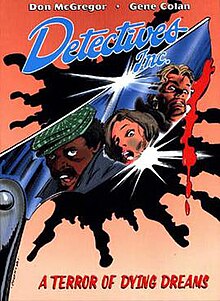Detectives Inc.
| Detectives Inc. | |
|---|---|
 Detectives Inc.: A Terror of Dying Dreams (1985). Cover art by Gene Colan | |
| Publication information | |
| Publisher | Eclipse Enterprises |
| Formats | Original material for the series has been published as a set of graphic novels. |
| Publication date | 1980: Detectives Inc.: A Remembrance of Threatening Green 1985: Detectives Inc.: A Terror Of Dying Dreams |
| Main character(s) | Ted Denning, Bob Rainier |
| Creative team | |
| Writer(s) | Don McGregor |
| Artist(s) | Marshall Rogers, Gene Colan |
| Letterer(s) | Tom Orzechowski, Mindy Eisman |
| Editor(s) | Dean Mullaney |
Detectives Inc. is a series of two
Publication history

The books' genesis, author
In 1980,
Eclipse Comics later reprinted the two graphic novels as color
In 1985, McGregor wrote and directed a low-budget, shot-on-video movie version of Detectives Inc., which has been shown at comic book conventions but remains unreleased commercially.[6][7][8]
Plot
Set in and around
Critical assessment
In a contemporaneous review of the first book,
Later assessments were largely positive. As a commentator at Ain't It Cool News wrote in 2001,
McGregor sought to create a realistic private detective comic book, and he succeeded in spades, producing a violent, touching and emotional story. ...[W]hat’s going on with the characters, how they relate to one another and the others in their lives, is equally as important as the plots they find themselves in. McGregor is as interested in why people do what they do and how they deal (or are unable to deal) with the demons they carry around. For the detectives, sometimes it seems the case is just a way of distracting them from their own problems, such as Denning’s attempts to deal with killing a teenage boy to save his partner in the prologue to the story, or Rainer’s ever-present strained relationship with his ex-wife".[11]
Writing of the 2001 edition of A Terror of Dying Dreams, Ben Herman of the website NegativePop.com said the story "is as much about these three individuals as it is about the solving of a mystery" and that "McGregor's introspective writing superbly portrays these characters, and establishes the realities they live in. While still occasionally ponderous, for the most part McGregor's narration is strikingly appropriate." He found Colan's black-and-white art, reproduced directly from pencil, "crisp and stunning. ... Visible is the intricate detail of his work, the subtle gradations of shadow and lighting that he utilizes. The emotions of McGregor's characters are vividly brought to life by Colan's illustration of their facial expressions and fluid body language."[12]
References
- ^ McGregor in Gough, Bob (n.d.). "Interview with Don McGregor". Mile High Comics. Archived from the original on November 23, 2001. Retrieved September 16, 2013.
- ^ "All That Is Left Is Anger". Don McGregor (official site). Archived from the original on February 9, 2015. Retrieved September 16, 2013.
- ^ "LGBT Comics Timeline > The 1980s". Gay League. Archived from the original on February 11, 2015.
- Fantagraphics Books. June 1, 1987.
- Fantagraphics Books. June 15, 1987.
- ^ Smith, Kevin Burton, ed. (n.d.). "Ted Denning & Bob Rainier". ThrillingDetective.com. Archived from the original on September 6, 2014. Retrieved September 16, 2013.
{{cite web}}:|first=has generic name (help)CS1 maint: multiple names: authors list (link) - ^ "Detectives Inc.". PS Productions. Archived from the original on July 10, 2007. (Movie stills)
- Fantagraphics Books. September 1, 1987.
- Fantagraphics Books. Archivedfrom the original on June 27, 2013. Retrieved July 21, 2013.
- Gillis, Peter (21 October 2009). "Review: Detectives Inc.: A Remembrance of Threatening Green". Comics Feature #6 (Oct. 1980) pp. 77-78, via Dailypop. Archivedfrom the original on October 25, 2009.
- ^ "Moriarty" (pseudonym) (October 9, 2001). "AICN Comics: Crime Comics Special!!". Archived from the original on December 20, 2008. " NOTE: Contains erroneous credit for first graphic novel's artist.
- ^ Herman, Ben (2001). "In My Not So Humble Opinion: Detectives, Inc: A Terror Of Dying Dreams". (Review) NegativePop.com. Archived from the original on September 30, 2007.
Further reading
- The Comics Journal #54 (March 1980): "From Detective to Detectives Inc.: An Interview with Marshall Rogers", pp. 56–70
- The Comics Journal #62 (March 1981): Review by R. Fiore, po. 8-9
- Wizard #13 (Spring 1980): "Marshall Rogers at Midnight" (interview), pp. 4–9
- Wizard #14 (Winter 1981): Review (with other works), pp. 34–37
External links
- Don McGregor (Official site)
- "Detectives, Inc.". Scoop. Gemstone Publishing / Diamond International Galleries. n.d. Archived from the original on February 21, 2015. Retrieved September 16, 2013.
